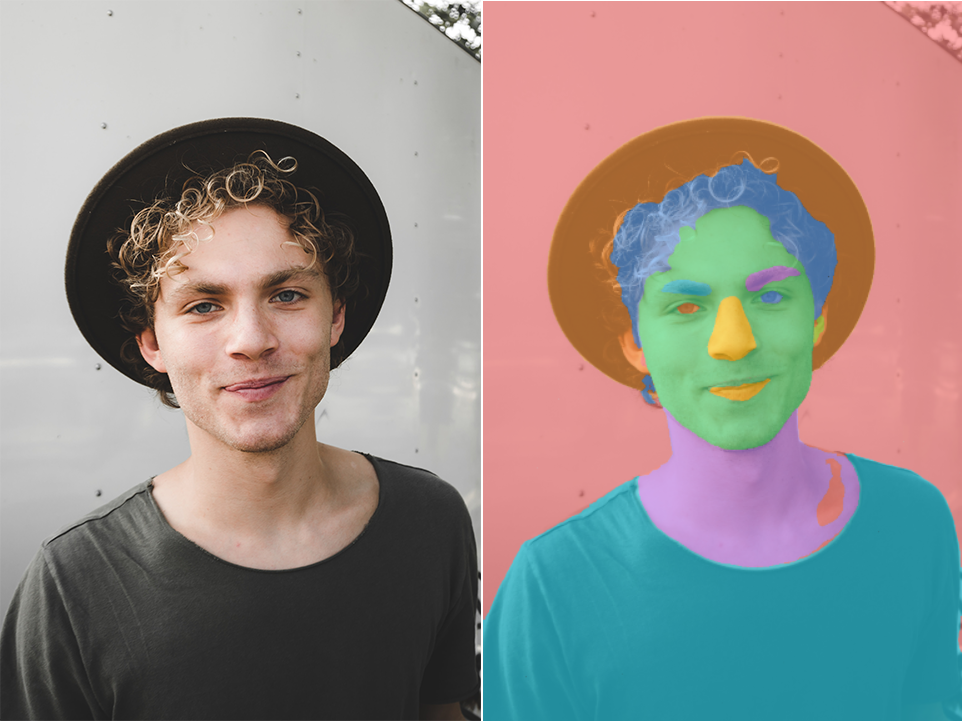metadata
language: en
library_name: transformers
tags:
- vision
- image-segmentation
- nvidia/mit-b5
- transformers.js
- onnx
datasets:
- celebamaskhq
Face Parsing
Semantic segmentation model fine-tuned from nvidia/mit-b5 with CelebAMask-HQ for face parsing. For additional options, see the Transformers Segformer docs.
ONNX model for web inference contributed by Xenova.
Usage in Python
import torch
from torch import nn
from transformers import SegformerImageProcessor, SegformerForSemanticSegmentation
from PIL import Image
import matplotlib.pyplot as plt
import requests
# convenience expression for automatically determining device
device = (
"cuda"
# Device for NVIDIA or AMD GPUs
if torch.cuda.is_available()
else "mps"
# Device for Apple Silicon (Metal Performance Shaders)
if torch.backends.mps.is_available()
else "cpu"
)
# load models
image_processor = SegformerImageProcessor.from_pretrained("jonathandinu/face-parsing")
model = SegformerForSemanticSegmentation.from_pretrained("jonathandinu/face-parsing")
model.to(device)
# expects a PIL.Image or torch.Tensor
url = "https://images.unsplash.com/photo-1539571696357-5a69c17a67c6"
image = Image.open(requests.get(url, stream=True).raw)
# run inference on image
inputs = image_processor(images=image, return_tensors="pt").to(device)
outputs = model(**inputs)
logits = outputs.logits # shape (batch_size, num_labels, ~height/4, ~width/4)
# resize output to match input image dimensions
upsampled_logits = nn.functional.interpolate(logits,
size=image.size[::-1], # H x W
mode='bilinear',
align_corners=False)
# get label masks
labels = upsampled_logits.argmax(dim=1)[0]
# move to CPU to visualize in matplotlib
labels_viz = labels.cpu().numpy()
plt.imshow(labels_viz)
plt.show()
Usage in the browser (Transformers.js)
import {
pipeline,
env,
} from "https://cdn.jsdelivr.net/npm/@xenova/transformers@2.14.0";
// important to prevent errors since the model files are likely remote on HF hub
env.allowLocalModels = false;
// instantiate image segmentation pipeline with pretrained face parsing model
model = await pipeline("image-segmentation", "jonathandinu/face-parsing");
// async inference since it could take a few seconds
const output = await model(url);
// each label is a separate mask object
// [
// { score: null, label: 'background', mask: transformers.js RawImage { ... }}
// { score: null, label: 'hair', mask: transformers.js RawImage { ... }}
// ...
// ]
for (const m of output) {
print(`Found ${m.label}`);
m.mask.save(`${m.label}.png`);
}
p5.js
Since p5.js uses an animation loop abstraction, we need to take care loading the model and making predictions.
// ...
// asynchronously load transformers.js and instantiate model
async function preload() {
// load transformers.js library with a dynamic import
const { pipeline, env } = await import(
"https://cdn.jsdelivr.net/npm/@xenova/transformers@2.14.0"
);
// important to prevent errors since the model files are remote on HF hub
env.allowLocalModels = false;
// instantiate image segmentation pipeline with pretrained face parsing model
model = await pipeline("image-segmentation", "jonathandinu/face-parsing");
print("face-parsing model loaded");
}
// ...
Model Description
- Developed by: Jonathan Dinu
- Model type: Transformer-based semantic segmentation image model
- License: non-commercial research and educational purposes
- Resources for more information: Transformers docs on Segformer and/or the original research paper.
Limitations and Bias
Bias
While the capabilities of computer vision models are impressive, they can also reinforce or exacerbate social biases. The CelebAMask-HQ dataset used for fine-tuning is large but not necessarily perfectly diverse or representative. Also, they are images of.... just celebrities.
